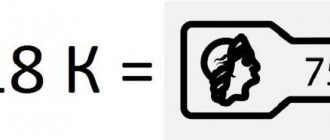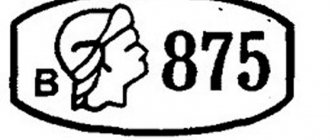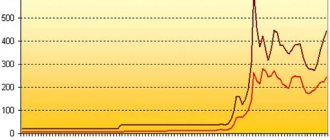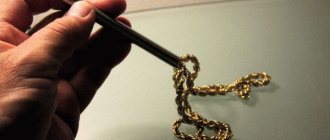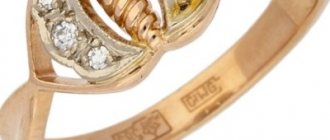18k gold alloy is often used to make jewelry, but where is 9k gold used? How are these two types of gold made, and what are the differences between them?
The 9-karat alloy consists of 9 parts pure gold and 15 parts additional metals such as silver, tin, nickel, zinc, palladium, etc.
In percentage terms, the purity of the 9-carat alloy is 37.5% pure gold in the total composition, which corresponds to 375 fineness according to the metric system adopted in Russia.
18 karat gold has 24 parts alloy with 18 parts pure gold. Therefore, its purity is 75%, i.e. 750 sample.
Due to its relatively high purity and durability, 18K is one of the most popular alloys used in the jewelry industry.
What is the difference between 9 and 18 carat gold?
As we've seen before, 9K and 18K differ significantly in purity.
Other important differences that depend on purity are the price, durability and color of 9K and 18K products.
Status of Gold: 9 karat gold is not always considered as such!
An important fact to take into account is that 18K alloy is always considered gold, while the status of 9K depends on the country where it is sold.
For example, in the United States, 9-karat jewelry cannot be sold as gold. In the USA, an alloy with a purity of at least 10 carats is considered gold.
Price.
The difference between 9 and 18 carats affects the price of the product. Since 9-karat jewelry contains less gold, it is valued much less per gram.
18k gold jewelry is significantly more expensive because it contains twice the percentage of pure precious metal.
Durability and hardness.
Gold is alloyed with other metals because it itself is very soft. Lower karat alloys will be harder than high karat alloys due to the different amounts of precious metal in their composition.
As a low purity gold alloy, 9K is harder than 18K. This means that 18K jewelry will be easier to scratch or warp.
9 carat jewelry is more durable due to its hardness.
Color.
Alloys with a high content of gold metal will have a richer yellow color than alloys with low purity.
Compared to 9 carat jewelry, 18 carat jewelry looks more rich. So, if you are looking for a ring or bracelet that looks more like solid gold, it is better to choose 18K jewelry.
Jewelry with 9K clarity should be chosen if price is more important to you than color.
What are the markings?
Jewelers introduced the concept of hallmark in order to unify the alloys used in the manufacture of jewelry. It was supposed to show what part of the jewelry alloy is pure gold, and what part of the alloy is the alloy, that is, other metals, such as copper or silver. Currently, two systems operate simultaneously: metric and carat, with the first being used in Russia and the CIS countries, and the second in America and some European countries.
Conformity between metric and carat systems:
- 24 carats, or 24 K, corresponds to a purity of 999% and above. Marking of gold bars.
- 23 carats, or 23 K, – 958%. High level alloy.
- 22 carats, or 22 K, – 916% or 917%. British coin alloy.
- 21 carats, or 21 K, – 875%. International coin alloy.
- 18 carats, or 18 K, – 750%. For expensive jewelry.
- 16 carats, or 16 K, – 666%.
- 14 carats, or 14 K, – 583% and 585%. Stable in air, widely used for making jewelry.
- 9 carats, or 9 K, – 375%. The alloy tarnishes in air, forming silver sulfide.
To convert the carat standard to metric, the first number must be divided by 24 and multiplied by 1000.
What standard in Russia corresponds to the foreign marking of ten carats? 10 carats are equal to 417 purity, so this type of jewelry is inferior in purity to the 585 carats that are most common in the former Soviet Union.
According to the legislation of the Russian Federation, foreign gold products with a purity of 10 carats, imported for subsequent sale, must be registered with the Russian State Assay Office.
After that, the jewelry will be stamped with the closest standard metric Russian gold marking, located on the level below. And this will only be 375% fineness; watch cases are usually coated with an alloy of this level. That is, on the territory of our country, 9 carat and 10 K gold will be completely equal in economic rights, and when sold they will be given the same price.
What purity should the gold in your jewelry be?
Simply put, gold purity is a measure of how much actual gold metal a piece of jewelry contains. The higher the karat of your gold jewelry, the easier it is to scratch.
If a piece of jewelry is described as pure gold, this means that it is made from a gold alloy and is not simply plated with gold.
“Gold plated” and “gold plated” are terms used to describe gold plated jewelry.
Products made from overlaid gold have a thicker layer of gold compared to gold plated ones. Choose false gold or gold-plated jewelry only for occasional wear, otherwise, if the item is worn frequently, its gold layer will quickly wear off.
If you want your jewelry to last longer, you need to buy pure gold.
Use of 9 karat gold
However, 375 sample also has special areas of application. Products made from this material have properties that are not typical for products made from pure noble metals: first of all, they are distinguished by lightness and hardness. In this regard, this material is widely used for inlaying everyday items of constant use, as well as for the manufacture of everything for which mechanical strength is important: watches, cigarette cases, and the like. Also, 375 gold is well suited as a material for wedding rings: they are durable and comfortable (but there is a risk of an allergic reaction).
It should also be noted that jewelry made from an alloy containing only 37.5% pure gold may lose its original luster over time, like jewelry made from silver and copper. The rules for caring for such jewelry are similar to the rules for handling silver jewelry.
Cleaning from copper and silver salts is carried out in an alkaline environment. It is often recommended to use ammonia, soda solution, or a mixture of both.
The soda solution can be heated to a boil, but you should still not boil jewelry in it. But dishwashing detergent, washing powder, toothpaste, glass cleaning liquid or regular soap also help.
Why is high purity not always good?
Typically, the higher the carat of gold jewelry, the more expensive it will be, but it will also look better. However, higher purity is not always desirable.
There is a reason why 24K is not widely used in jewelry, and it has to do with the physical properties of the metal. Gold is very soft and any item made solely from it will bend easily.
This is why it is mixed with other metals, resulting in jewelry that is more durable (and also cheaper).
Due to the softness of gold, the higher the karat of your jewelry, the more easily it will scratch. (This is generally true, but not always - it also depends on what other metals are in the composition).
LiveInternetLiveInternet
Pure gold is now found only in bullion (and in exotic jewelry in Japan). Gold is never used on its own in jewelry due to its fragility and softness. Impurities of silver, copper, and less often platinum are always added to a jewelry alloy to strengthen the alloy and protect it from external influences. By the way, depending on the composition of impurity metals (ligatures), the color of jewelry gold changes. For example, the more copper there is in the alloy, the redder the gold. Silver, on the contrary, gives gold a lighter, lemony tint. The amount of impurities in jewelry gold is clearly regulated. Depending on the content of pure gold in the jewelry alloy, different samples of gold are distinguished. The higher the proportion of gold in the jewelry, the higher the purity it has. The gold standard determines not only the color fastness, but also the hardness of the metal. Gold samples differ here and in Europe. If we have a metric sample system (samples show the content of pure gold in a jewelry alloy), then in Europe it is a carat system (the number of carats shows how many parts of pure gold are in the alloy). Metric gold hallmark system In this system, the hallmark indicates the percentage of pure gold in an item. For example, 585 standard means that the jewelry contains 58.5% pure gold. Everything else (41.5%) is a ligature, i.e. addition of other metals. Pure gold itself is too soft, and a ring made from it will not last long. Therefore, you have to sacrifice a little of its shine and add other metals to the alloy to ensure the longevity of your jewelry.
In jewelry, a ligature is an addition of base metal to jewelry made of precious metals or a coin. Used to bring the jewelry alloy to a certain standard.
The ligature in gold items can be a mixture of silver, copper, palladium or nickel. It is thanks to the ligature that jewelry gold comes in different colors: yellow, white, pink, green, etc. The most common gold hallmarks in the CIS are 585 and 750. The 583 hallmark is practically no different from 585, but is now practically not used (583 was replaced by the 585 hallmark back in 1978). The only disadvantage of gold of this standard is that jewelry made from it is not listed in Europe. Such a test simply does not exist there. Most often, 585 standard is used in gold jewelry. 375 and 500 samples are used much less frequently. From 750 samples, works of art are already made. What is important here is not the gold content itself, but the work of the master, the complexity of the execution. The metric system described above is adopted in the CIS and in the countries of the Vienna Convention (Austria, Germany). In some European countries and America, a different carat system is used.
Gold karat system
Carat (from Italian carato, through Arabic kirat, from Greek kerátion (κεράτιον) - a carob pod, the seeds of which served as a measure of mass) is a unit of measurement of mass and volume, as well as a measure of the purity of gold. If in the metric system pure gold is an alloy containing 99.9% of gold itself, then in the karat system it is 24 carats. Just like the number in the metric ring, gold karat indicates how much pure gold is contained in a jewelry alloy. Thus, 18 carat gold indicates that the alloy of the jewelry contains 18 parts (karats) of gold and 6 parts of ligature. Those. in such a gold alloy there is 75% gold, and it corresponds to our 750 standard gold. In Europe, 18 and 14 carat gold is most often used; in Britain, 9 carat gold is also popular. In Portugal, gold is found with a unique carat value of 19.2 carats. In the United States, 10 and 14 karat gold is used, but 10 karat is the predominant gold. In the Middle East, India and Southeast Asia, jewelry is traditionally 22 karat (sometimes even 23 karat). In China and Hong Kong, gold of almost 24 carats is popular. The higher the percentage of gold (or carat value) in gold jewelry, the brighter the color of the gold and the higher the value of the jewelry.
Relationship between gold assay systems
Metric assay system[/td]
| Carat sample system | Share of pure gold in jewelry alloy | |
| 999 | 24 | 99,9% |
| 958 | 23 | 95,8% |
| 750 | 18 | 75% |
| 585 | 14 | 58,5% |
| 583 | (14) | 58,3% |
| 500 | (12) | 50% |
| 375 | (9) | 37,5% |
Why are low carats bad?
The good thing about low carats is that they are usually cheaper. Additionally, high amounts of other metals in a gold alloy can make it stronger.
On the other hand, when purchasing low karat jewelry, you need to keep in mind that gold, which is not 100% pure, is often mixed with nickel.
Therefore, if you are allergic to this metal, wearing such jewelry may be problematic for you.
In such cases, it is better to avoid 10 karat gold.
However, if you don't want to pay for higher carats, stick to 14 or 18 carats.
An Important Question When Buying Multi-Stone Jewelry
If you are purchasing rings with multiple diamonds set and there is a center stone (usually the largest), be sure to ask for complete information about that diamond. This is because the center diamond usually makes up the bulk of the ring's cost.
This will allow you to estimate the price of the ring and, therefore, correctly calculate the benefit of the deal.
Having said that, I know that most jewelers do not want to mislead consumers with malicious intent. Most of them simply want to offer consumers the choice to buy something big.
Don't be afraid of the term "total carat weight" because it can be useful information once you know what it means.
More detailed information can be found at https://beyond4cs.com/carat/what-is-carat-total-weight/

